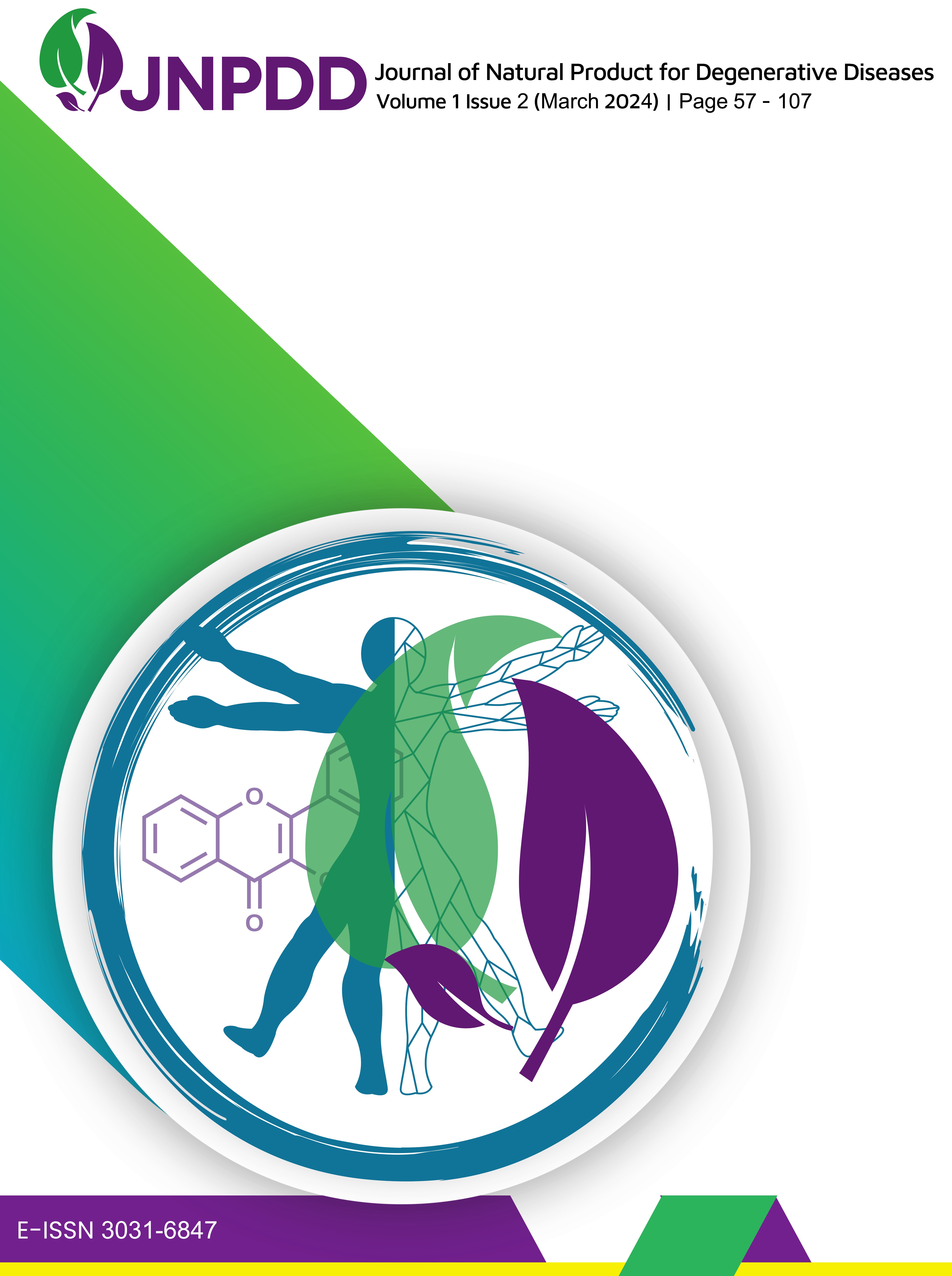The Formulation and Test of Antioxidant Activity from Serum Gel of the Extract Chrysanthemum Flower (Chrysanthemum Indicum L.)
Abstract views: 510 | PDF downloads: 484
Abstract
Skin as the outermost layer of the body will be first exposed to UV light, and pollution which may form free radicals and lead to premature aging, so the application of antioxidants is indispensable. One of the skin cares that are in great demand is serum. A plant that has a high content of antioxidants and is widely cultivated in Indonesia is the chrysanthemum flower (Chrysanthemum indicum L.). Previous research stated that the IC50 value of chrysanthemums was 43.34 ppm. This study aimed to determine the IC50 value contained in chrysanthemum flower extract and formulate it into serum gel that contains antioxidants and meets physical parameters. The method used in determining the IC50 value is the DPPH method. The formulation was carried out by adding different levels of chrysanthemum flower extract to the formula. The evaluation test includes organoleptic, pH, spreadability, viscosity, and antioxidant activity and stability test at room temperature (25oC) and high temperature (40oC). The results obtained were IC50 values of chrysanthemum flower extracts was 32.78 ± 0.01 ppm while the IC50 of serum gel were 109.10 ± 0.1 ppm (F1) and 73.51 ± 0.08 ppm (F2) and after 4 weeks stored at room temperature the IC50 114.02 ± 0.09 ppm (F1) and 76.39 ± 0.06 ppm (F2). The conclusion is that chrysanthemum flower extract has a very strong antioxidant activity, and the serum gel has a strong antioxidant activity and is stable at both room temperature and 40oC for 4 weeks.
References
Hadizadeh H, Samiei L, Shakeri A. Chrysanthemum, an ornamental genus with considerable medicinal value: A comprehensive review. South African J Bot. 2022;144:23–43.
Apriliani E, Widyajayantie D, Hidayah UF, Yudha YS. Perbanyakan Tanaman Chrysanthemum pada Kondisi Fotoautotropik Secara in Vitro. Agric Biol Technol. 2023;1(1):1–9.
Shao Y, Sun Y, Li D, Chen Y. Chrysanthemum indicum L.: A comprehensive review of its botany, phytochemistry and pharmacology. Am J Chin Med. 2020;48(04):871–97.
Hutapea M, Swandiny GF, Syafawi MI, Putra FP, Kokadir S, Basilianus E, et al. The Latest Research on 3 (Three) Types of Sea Cucumber Extract from Tegal Mas Island, Lampung. J ILMU KEFARMASIAN Indones. 2023;21(2):165–71.
Jaganjac M, Sredoja Tisma V, Zarkovic N. Short Overview of Some Assays for the Measurement of Antioxidant Activity of Natural Products and Their Relevance in Dermatology. Molecules. 2021;26(17):5301.
Youssef FS, Eid SY, Alshammari E, Ashour ML, Wink M, El-Readi MZ. Chrysanthemum indicum and Chrysanthemum morifolium: chemical composition of their essential oils and their potential use as natural preservatives with antimicrobial and antioxidant activities. Foods. 2020;9(10):1460.
Shunying Z, Yang Y, Huaidong Y, Yue Y, Guolin Z. Chemical composition and antimicrobial activity of the essential oils of Chrysanthemum indicum. J Ethnopharmacol. 2005;96(1–2):151–8.
Joo SY. Antioxidant activities of medicinal plant extracts. J Korean Soc food Sci Nutr. 2013;42(4):512–9.
Fauziah A, Sudirga SK, Parwanayoni NMS. Uji Antioksidan Ekstrak Daun Tanaman Leunca (Solanum nigrum L.) Antioxidant Test Leunca Plant Leaf Extract (Solanum nigrum L.) Affrina Fauziah1*, Sang Ketut Sudirga2, Ni Made Susun Parwanayoni3.
Choi KT, Kim JH, Cho HT, Lim SS, Kwak SS, Kim YJ. Dermatologic evaluation of cosmetic formulations containing Chrysanthemum indicum extract. J Cosmet Dermatol. 2016;15(2):162–8.
Khan N, Ahmed S, Sheraz MA, Anwar Z, Ahmad I. Pharmaceutical based cosmetic serums. In: Profiles of Drug Substances, Excipients and Related Methodology. Elsevier; 2023. p. 167–210.
Gallo M, Formato A, Ianniello D, Andolfi A, Conte E, Ciaravolo M, et al. Supercritical fluid extraction of pyrethrins from pyrethrum flowers (Chrysanthemum cinerariifolium) compared to traditional maceration and cyclic pressurization extraction. J Supercrit Fluids. 2017;119:104–12.
Departemen Kesehatan RI. Farmakope herbal Indonesia. Jakarta: Kementerian Kesehatan RI; 2017. 1–506 p.
Gori A, Boucherle B, Rey A, Rome M, Fuzzati N, Peuchmaur M. Development of an innovative maceration technique to optimize extraction and phase partition of natural products. Fitoterapia. 2021;148:104798.
Momchev P, Ciganović P, Jug M, Marguí E, Jablan J, Zovko Končić M. Comparison of Maceration and Ultrasonication for Green Extraction of Phenolic Acids from Echinacea purpurea Aerial Parts. Molecules. 2020;25(21).
Kumar Hotta S, Neelapu N, Priyanka N. Phytochemical analysis of the flower of Chrysanthemum indicum L. and Calendula officinalis. Int J Pharmacogn Chem. 2021;2(1):35–41.
Liang W-L, Gong D, Zhang WK. The Composition of chrysanthemum extracts and their pharmacological functions. STEMedicine. 2020 Dec 16;2(5 SE-Review articles).
Xia DZ, Lv GY, Yu XF, Wang HM, Yang Q. Antagonism of total flavonoids from Chrysanthemum morifolium against lead induced oxidative injury in mice. Zhongguo Zhong yao za zhi= Zhongguo Zhongyao Zazhi= China J Chinese Mater Medica. 2008;33(23):2803–8.
Pratami DK, Mun’im A, Sundowo A, Sahlan M. Phytochemical profile and antioxidant activity of propolis ethanolic extract from Tetragonula bee. Pharmacogn J. 2018;10(1):73–80.
Han A-R, Nam B, Kim B-R, Lee K-C, Song B-S, Kim SH, et al. Phytochemical composition and antioxidant activities of two different color chrysanthemum flower teas. Molecules. 2019;24(2):329.
Fernandez-Panchon MS, Villano D, Troncoso AM, Garcia-Parrilla MC. Antioxidant activity of phenolic compounds: from in vitro results to in vivo evidence. Crit Rev Food Sci Nutr. 2008;48(7):649–71.
Syarifah A, Budiman A, Nazilah SA. Formulation and Antioxidant Activity of Serum Gel of Ethyl Acetate Fraction From Musa x paradisiaca L. In: 4th International Conference on Sustainable Innovation 2020–Health Science and Nursing (ICoSIHSN 2020). Atlantis Press; 2021. p. 310–5.
Aulifa DL, Noerfitri RY, Tristiyanti D, Budiman A. Formulation of Serum Gel Containing Angelica keiskei Leaf Extract as an Antioxidant and Tyrosinase Enzyme Inhibitor. Int J Appl Pharm. 2020;12(3):108–11.
Nur A, Rani R. The Potential of Tradescantia Spathaceae Leaves Infusion as Sunscreen Gel Use Spectrophotometric UV-Vis Method. J ILMU KEFARMASIAN Indones. 2022;20(1):6–13.




